How Big Does a Columbian Black and White Tegu Get
Tegus are giant lizards from Central and South America. Many of these lizards are either sold as pets, or are an invasive species in the states of Georgia, Florida and South Carolina.
Keeping one of these lizards is very rewarding, but it is also a challenge as they need advanced care and husbandry.
It is important to learn about the different types of Tegus and how to identify them. Some can grow to be over four feet in length and aggressive. Others make great pets and are intelligent and docile.
Are you interested in identifying one of these giant lizards? Keep reading to learn more about Tegu lizards and the different morphs and species.
Table of Contents
- What Is a Tegu Lizard?
- Tegu Species
- 9. Crocodile Tegu
- 8. Albino
- 7. Purple Tegu
- 6. Caiman Lizard
- 5. Colombian Gold Tegu
- 4. Argentine Red
- 3. Chacoan White Headed
- 2. Blue Tegu
- 1. Argentine Black and White Tegu
- Summary
What Is a Tegu Lizard?
Tegu is the common name for two families of lizards (Teiidae and Gymnophthalmidae) that are native to Central and South America.
In these two families there are over 400 different species of lizards that span a range of over 1,000 miles. Because these lizards span such a wide range, they live in many different habitats including: rainforest, savannas, semi-deserts, swamps and lagoons. This means they can live in many different types of environments and are invasive.
There are several populations of wild Black and White Argentine Tegus currently living in Florida. Many unsuspecting pet owners buy a Tegu, that they are unprepared to care for, and release them into the wild.
Tegus are often mistaken for savannah monitor lizards as they are large and bulky, but the two species are not closely related. Many Tegus are about three to five feet long and can weigh as much as 20 pounds!
Because of their large size they cannot be kept in small enclosures. They need lots of space and activities to keep them busy, both inside and outside their tank.
They should spend most of their time in their cage, but should be let out once a day. Inside their tank, they may want to swim or bask. Outside, they like to walk around and will need supervision. They are very intelligent reptiles and can even be house trained.
Many Tegus are easy to spot as they have black and white banding patterns, but some are speckled, red, orange, yellow and green. They often have long snouts and thick necks. They have small scales, forked tongues, and five distinct toes.
Tegus also tend to look like they have lots of skin, with folds in the neck. They have stocky bodies and thick, heavy tails. In the wild, you may find them on the ground, up in a tree, or in the water. Their individual characteristics all depend on the species and morph.
Dwarf, Crocodile, Desert, Sun and Four-Toed Tegus should not be kept as pets. There are also plenty of other species in Central and South America, as well as in the pet trade, that should not be pets.
Caiman, Argentine Red, Blue and Argentine Black and White Tegus are some of the best pet species.
Deciding to adopt a Tegu is a big decision. They are very smart and large lizards that need plenty of living space and exercise. They take lots of time and dedication that not every reptile owner can provide. However, if you have decided that a Tegu is for you, then read below to learn about the different species and what to consider…
Tegu Species
| Tegu | Color | Size | Rank |
|---|---|---|---|
| Albino (morph) | White | 4 to 5 feet | 8 |
| Argentine Black and White | Black and White | 5 feet | 1 |
| Argentine Red | Black and red | 3 to 4.5 feet | 4 |
| Blue (morph) | Black and light blue | 5 feet | 2 |
| Caiman | Red, orange, yellow, and green | 2 to 5 feet | 6 |
| Chacoan White Headed | Black and white, with a white head | 3 to 4.5 feet | 3 |
| Colombian Gold | Black and gold | 2 to 3 feet | 5 |
| Crocodile | Brown-yellow, red, and gray Green, black, and red | 18 inches | 9 |
| Purple (morph) | Green and black, but can be a mix of more colors | 3 to 4 feet | 7 |
9. Crocodile Tegu
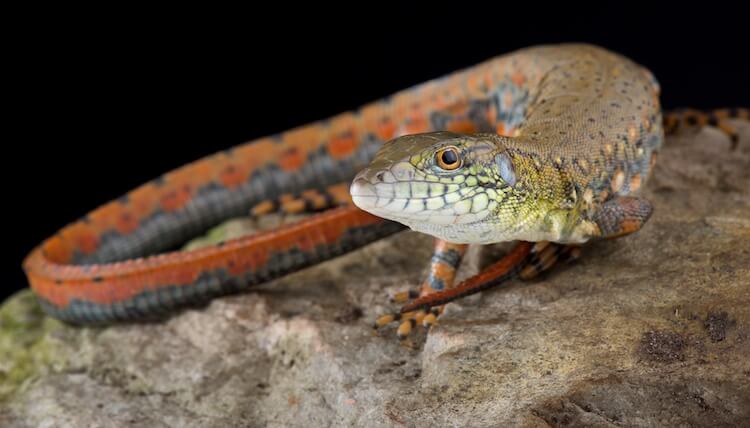
Crocodile Tegus are some of the smallest and rarest species. Their natural range is Colombia, Venezuela, French Guinea, Brazil and Peru.
This species does not actually look like a crocodile, but it has a thin body, long tail and square head. Their heads are typically green-brown in color and most of their body is brown-gray with a gray and red tail.
Like crocodiles, this Tegu enjoys being in the water. They have short legs to help them swim and are often found in streams or lagoons. They can be found living near Caiman Lizards, but they do not interact often or compete for food due to a difference in diet. Caiman Lizards only eat mollusks. Crocodile species eat arthropods, crustaceans, fish and different frog species.
Crocodile species are not found in the pet trade.
They should not be kept as pets and are not commonly found for sale.
This species is even rare to find in the wild. On the rare occasion that one is found in the wild, it should be left to continue populating. When a Crocodile Tegu does find its way to the pet trade, they may sell for as much as $13,000.
It is possible to see them kept by highly experienced herpetologists and field researchers. Sometimes they are even kept in a zoo, but they are not for someone looking for a lizard pet.
| Appearance and Range | |
|---|---|
| Color | Brown-yellow, red, and gray Green, black, and red |
| Range | Colombia, Venezuela, French Guinea, Brazil, and Peru |
| Pet Friendly | No |
| Size | 18 inches |
8. Albino
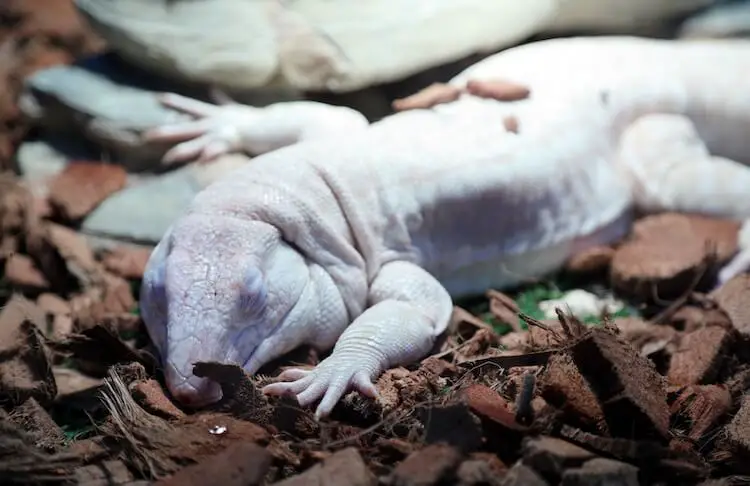
An Albino Tegu is not a species in itself, but it is an Argentine Tegu morph. Similar to how herpetologists selectively breed other lizard like bearded dragon morphs, they also breed Argentine morphs.
Albinos lack the pigmentation of wild-type Argentine species. This means they often have lots of white coloring on their skin and they may also have different patterns too. Sometimes they also have pale gray-black bands or red spots.
There are also ice albino Tegu morphs which are an example of two morphs being bred together. The Ice and Albino Tegu has a lighter whiter skin.
Albino Tegus are not very common in the pet trade, and are usually only kept by experienced herpetologists. They can cost as much as $3000!
| Appearance and Range | |
|---|---|
| Color | White |
| Range | Captive-bred morph |
| Pet Friendly | Yes |
| Size | 4 to 5 feet |
7. Purple Tegu
Purple Tegus are not an actual species of Tegu, they are a morph; just like the Albino above.
Although they can be found naturally in South America, it is thought they are a hybrid of the Blue and Red Tegu. This is what gives the Purple its name. But, they are not actually purple!
Unlike the Albino Tegu, they are not always selectively bred. The Red and Blue Tegu is also a natural morph that can be found in the wild.
Purple species are normally black and green.
The Purple Tegu is just like any other Argentine species with an intelligent and personable nature. They are generally more expensive due to their rare status and cost $200 to $400.
| Appearance and Range | |
|---|---|
| Color | Commonly green and black, but can be a mix of more colors |
| Range | Argentina, Paraguay, and Brazil |
| Pet Friendly | Yes |
| Size | 3 to 4 feet |
6. Caiman Lizard
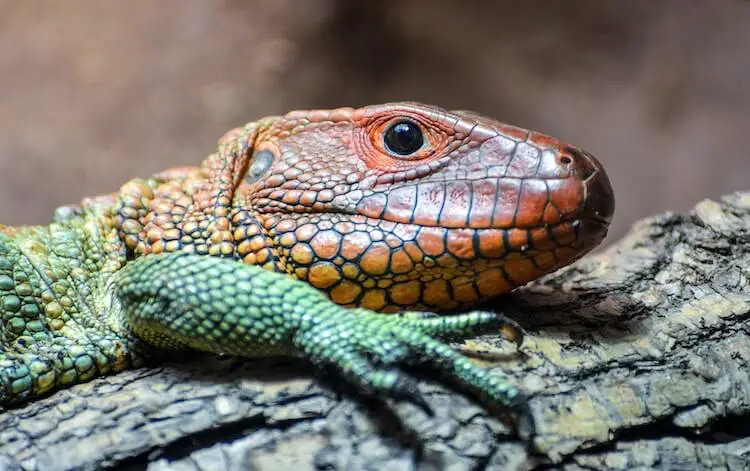
Caiman Lizards (Water Tegu) are not the most common Tegu species, but they are in high demand as pets. This demand means they are expensive and cost about $400 to $500.
They are a very rewarding lizard and enthusiasts love them for their bright colors. They often have a bright red or orange head with a green body.
Caimans can grow up to five feet and are one of the largest Tegu species.
As well as being agile climbers and strong swimmers, they are very intelligent and loyal. If kept as a pet they must have large areas to swim and climb. In the wild, you will often find this colorful lizard resting on tree branches or swimming in the water. They can be identified by their unique color patterns and these resting places, as not many Tegus like the water like Caiman Lizards do.
A tall cage with sturdy branches will suit their need to climb, and a small pool with 12″ of water is enough for them to swim in. An owner should be prepared to dedicate a large part of their house to this lizard.
Unlike most Tegus in this list, Caiman Lizards mostly eat aquatic snails. They have very powerful jaws to eat this unique diet. Although they are not aggressive, owners should be aware of their strong bite.
| Appearance and Range | |
|---|---|
| Color | Red, orange, yellow, and green |
| Range | Ecuador, Colombia, Paraguay, Peru, and Brazil |
| Pet Friendly | Yes |
| Size | 2 to 5 feet |
5. Colombian Gold Tegu
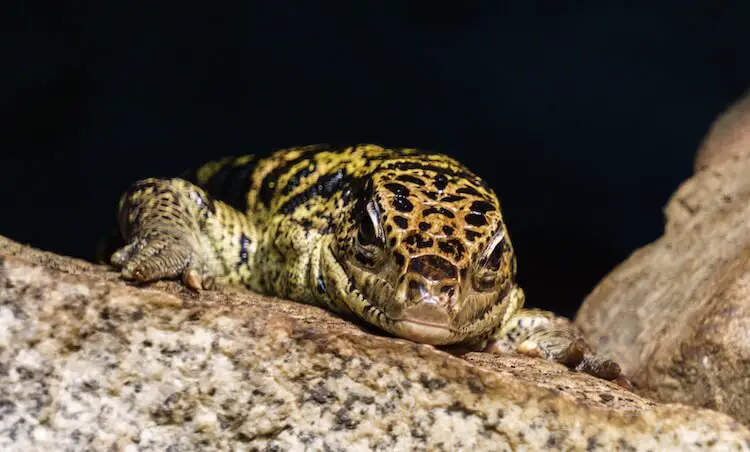
Colombian Gold Tegus are a very small species. They are much smaller than the more popular Argentine types.
Their skin is a gold-brown color with black bands.
Like all Tegus, they are stocky and have thick bodies and tails. Unlike most, they are not climbers so need more floor space in their enclosure. They need a secure enclosure where they can dig and explore.
Colombian Tegus can be kept as a pet, but they are not as easy to keep or as docile as Argentine Tegus. They are known to be more aggressive than Argentines.
They are recommended for keepers who have previously owner Tegus and are committed to caring for them correctly. Colombian Golds are one of the cheapest species and cost around $100.
| Appearance and Range | |
|---|---|
| Color | Black and gold |
| Range | Colombia |
| Pet Friendly | Sometimes |
| Size | 2 to 3 feet |
4. Argentine Red
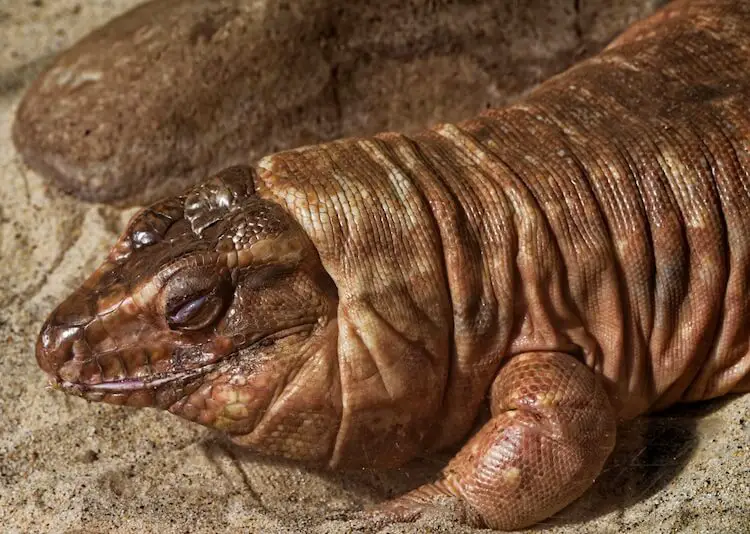
The Argentine Red Tegu is mostly red-brown in color, although some species occasionally have black or white speckled skin.
Argentine Reds are one of the more popular pet species and cost $300 to $400.
They are much easier to keep than other Tegus due to their ease of care and ability to be easily tamed. They are very docile and intelligent lizards. With careful handling, training, and care, they can become trained to an extent.
Argentine Reds are closely related to the Black and White Argentine (which is also on this list), but are smaller at three feet in size.
Just because they are slightly smaller does not mean they should live in a smaller enclosure.
Red Tegus still need plenty of room to roam and exercise. A Tegu enclosure should be at least twice the length of your lizard, if not larger, and have both a pool of water and a basking area.
| Appearance and Range | |
|---|---|
| Color | Black and red |
| Range | Western Argentina, Bolivia, and Paraguay |
| Pet Friendly | Yes |
| Size | 3 to 4.5 feet |
3. Chacoan White Headed
Chacoan White Headed Tegus are also known as the Paraguayan Black and White Tegu. They are one of the most northern species and are named after their pure white head. They are actually born with green heads, but it fades to white within their first few years. They normally have black and white mottled skin, spots and bands.
Apart from their white head, they look very similar to the Argentine Black and White.
Argentine Tegus originate from Argentina and spread to bordering countries, the Chacoan originates from Paraguay and increased its range to: Argentina, Brazil, Uruguay and Bolivia.
Not only are they similar to Argentines in size and color, but they are also very similar in personality and care. They also make a great first-time Tegu and cost $200.
| Appearance and Range | |
|---|---|
| Color | Black and white, with a white head |
| Range | Argentina, Brazil, Uruguay, Paraguay, and Bolivia |
| Pet Friendly | Yes |
| Size | 3 to 4.5 feet |
2. Blue Tegu
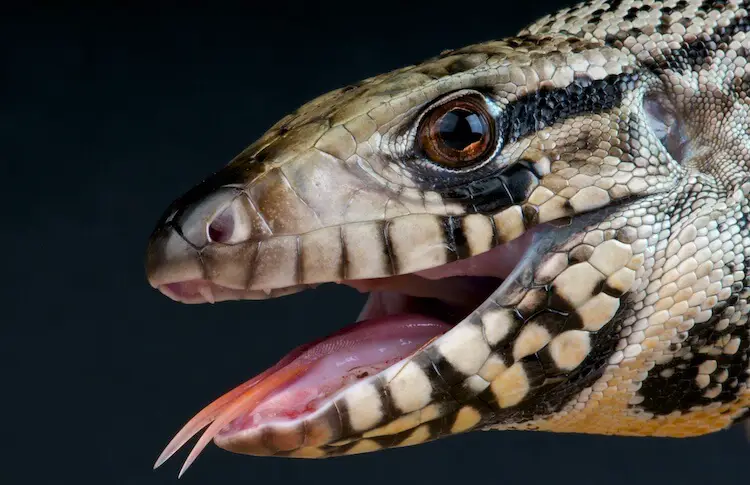
The Blue is the last of the Black and White Argentine morphs on our list.
It is their light blue tint that gives them a special appearance and name. This coloration is mostly seen in mature males. Their overall color is black and light blue, but it can vary from blue to albino to a high white morph.
Many Blue Tegus also have a special "singe mark" on their nose. This black spot gives them the appearance that their nose is singed from a flame.
Their care and intelligence is the same as most Argentine Tegus, but they do not normally grow longer than three feet.
If you are looking for a unique Argentine Tegu, the Blue morph may be for you, but they cost a little bit more at $250 to $600.
| Appearance and Range | |
|---|---|
| Color | Black and light blue |
| Range | Argentina, Brazil, Paraguay, and Uruguay |
| Pet Friendly | Yes |
| Size | 3 feet |
1. Argentine Black and White Tegu
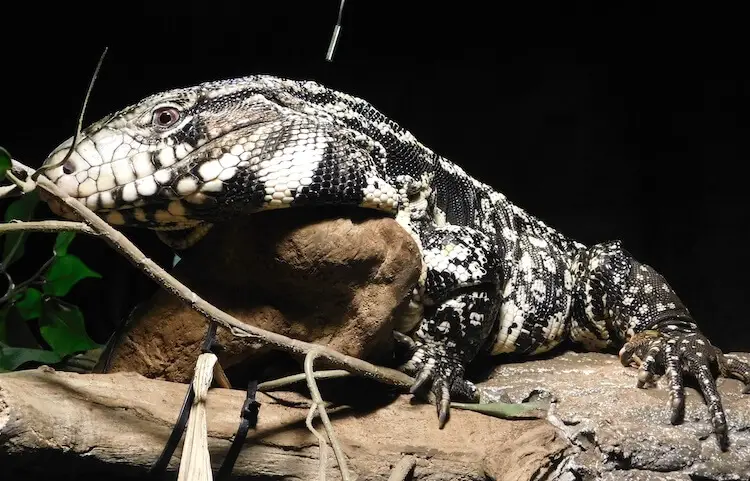
Argentine Black and Whites are the most popular Tegu pet.
Black and White Tegus are the biggest of all and so are known as Argentine Giants. They are also the most docile. When they are handled gently and regularly they are gentle giants. However, without regular handling, they can become aggressive and have a powerful bite.
Argentine Black and White Tegus have characteristically bead-like scales. They received their name due to the black and white banding pattern on their bodies and many black and white speckles. They have thick bodies and tails, small eyes, and a forked tongue.
If you are new to Tegus, and have decided on this species, they make a great choice and can be purchased for $200 to $550.
With the right setup and routine husbandry, they can live for 15 to 20 years.
| Appearance and Range | |
|---|---|
| Color | Black and White |
| Range | Argentina, Brazil, Paraguay, and Uruguay |
| Pet Friendly | Yes |
| Size | 5 feet |
Summary
If you have never kept a Tegu before, a species of Argentine is the best choice for you.
Argentine Tegus are the largest of all, but they are also the most docile and make the best choice for first-time owners. Whether it is a Red, or a Black and White, Argentine Tegus make great pets when given a big tank and proper care.
If you are a more experienced keeper, you may want to consider a Colombian Tegu. Colombian species can make very interesting and unique pet lizards, but they are more aggressive so need a more experienced handler.
Finally, if you are looking for a morph, you may want to consider a Blue, Purple, or Albino. These Tegus are sure to stand out with their beautiful colors and patterns.
No matter what species you decide upon, it will be a loyal lizard for years to come. Do you have a pet Tegu? Comment below to share your experience.
How Big Does a Columbian Black and White Tegu Get
Source: https://www.everythingreptiles.com/tegu-lizards/